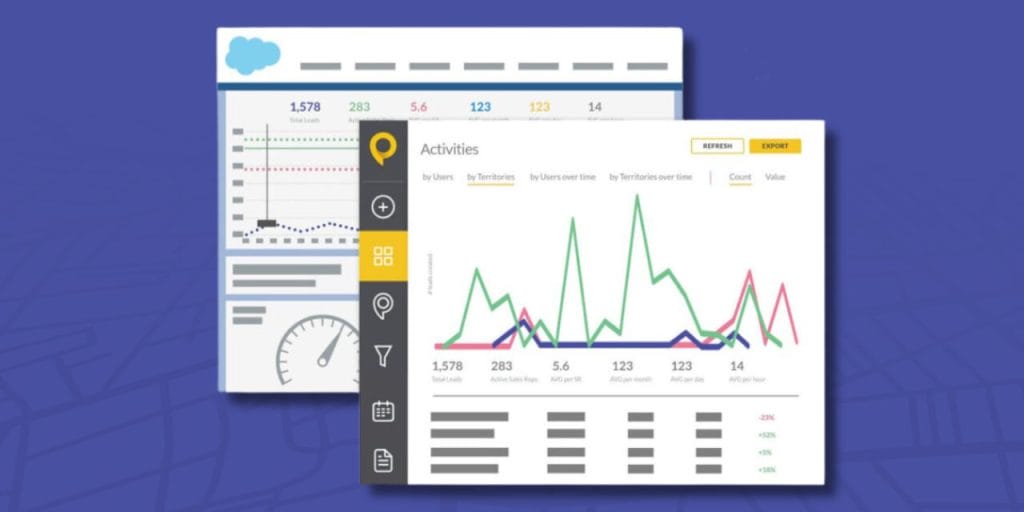Does this sound familiar? You’re staring at a spreadsheet from last week, trying to understand why your Northeast territory missed quota while the Southwest exceeded expectations. By the time patterns emerge from static reports, your opportunities have already slipped away. Your deals have stalled. Competitors have moved ahead.
This happens if you rely on outdated reporting methods. Sales reporting dashboards solve this problem by providing real-time intelligence. They transform reactive management into proactive strategy, eliminating costly guesswork. They accelerate decision-making when timing matters most. They turn every field interaction into measurable business growth.
To manage a sales team effectively, you need instant access to performance metrics. You need up-to-date territory insights and pipeline health data. Sales reporting dashboards bridge the critical gap between your data collection and strategic execution. They empower you to spot trends, identify bottlenecks, and optimize team performance before opportunities disappear. Unlike static monthly reports that arrive too late to influence outcomes, dynamic dashboards pulse with live data. This fundamentally changes how field teams operate and win.
What Is a Sales Reporting Dashboard?
A sales reporting dashboard is a centralized, visual interface. It aggregates real-time sales data from multiple sources into customizable charts, graphs, and metrics.
Traditional sales reports present historical data in static formats. Dashboards provide dynamic, interactive displays that update automatically. New information flows through your sales system instantly.
The fundamental difference lies in timing and interactivity. Standard sales reports deliver periodic snapshots:
- Weekly summaries
- Monthly analyses
- Historical performance data
Sales dashboards operate in real-time. They display:
- Current pipeline status
- Today’s activities
- Immediate performance indicators
This enables instant course corrections.
Dynamic dashboards adapt to user preferences and roles. Sales reps focus on personal metrics while managers monitor team-wide performance. This flexibility ensures every stakeholder accesses relevant data without information overload.
Static dashboards display fixed views. These may not align with individual needs or changing business priorities.
Modern sales reporting dashboards integrate seamlessly with multiple systems:
- CRM platforms
- Communication tools
- Field sales applications
This creates a unified view of customer interactions across all touchpoints. Integration eliminates data silos and provides the comprehensive visibility essential for field sales success.
Benefits of Sales Reporting Dashboards
Real-time data tracking revolutionizes how field teams respond to market changes. Sales professionals no longer wait for end-of-week reports. They access current pipeline status, lead progression, and territory performance instantly. This immediacy enables proactive adjustments that prevent missed opportunities and accelerate deal closure.
Customizable dashboard views ensure every team member sees relevant metrics without distraction. The personalization works like this:
- Sales reps focus on personal quotas, upcoming appointments, and individual pipeline health
- Managers monitor team performance, territory coverage, and coaching opportunities
- Executives track revenue trends across all channels
This personalization maximizes productivity by eliminating irrelevant information.
Enhanced data visibility breaks down information barriers that traditionally separated departments. Marketing teams see which campaigns generate qualified leads. Sales managers identify top performers and struggling territories. Executives track revenue trends across all channels. This transparency fosters collaboration and aligns organizational efforts.
Faster decision-making emerges when data becomes instantly accessible and visually clear. Managers spot underperforming territories within hours rather than weeks. This enables immediate resource reallocation. Sales reps identify hot prospects requiring urgent attention. This prevents deals from cooling due to delayed follow-up.
Dashboard reporting also improves accountability and motivation. Performance becomes visible across the organization. Healthy competition emerges when team members see real-time rankings. Managers provide timely coaching based on current activities rather than outdated reports.
How to Set Up a Sales Reporting Dashboard
Define your objectives
Before selecting metrics or tools, determine whether your primary goals involve:
- Increasing conversion rates
- Shortening sales cycles
- Improving territory coverage
- Enhancing team productivity
Clear objectives guide metric selection and dashboard design. This prevents information overload that dilutes focus.
Identify your sales metrics
Choose metrics based on established objectives and organizational priorities. Focus on actionable indicators that directly influence revenue outcomes. Avoid vanity metrics that look impressive but provide limited insight. For example, the total number of activities like calls made or emails sent can create false productivity impressions. High activity volumes don’t guarantee quality interactions or revenue generation.
Balance leading indicators (activities) with lagging indicators (results). This creates comprehensive performance visibility.
Choose the right dashboard software
Your dashboard should integrate seamlessly with existing systems. Look for platforms that provide the flexibility your team requires. SPOTIO’s reporting platform excels in field sales environments. It offers mobile-optimized dashboards that work reliably in any location.
Evaluate these factors before committing to any solution:
- Integration capabilities
- Customization options
- User experience
- Mobile functionality
Integrate all data sources
To create a unified view of sales performance, connect your CRM, email platforms, communication tools, and field sales applications. This eliminates data silos. Integration ensures dashboard accuracy while reducing manual data entry that introduces errors and delays.
Implement, test, and share your sales dashboard
Use a phased approach to implement, test, and share your sales dashboard. This allows for refinement based on real-world usage.
Start with core metrics and essential users. Then expand functionality based on feedback and evolving needs. Provide training to ensure team members understand how to interpret data and take appropriate actions.
Regular testing identifies technical issues and usability problems before they impact daily operations. Gather user feedback to optimize layouts, adjust metrics, and improve overall effectiveness. Share best practices across teams to maximize dashboard adoption and value realization.
Key Metrics to Track in Your Sales Reporting Dashboard
Tracking the right metrics transforms sales dashboards from pretty visualizations into revenue-generating tools. Focus on indicators that directly influence decision-making and provide insights for immediate improvement.
New business revenue
New business revenue measures your team’s ability to acquire fresh customers and expand market presence. This metric reveals territory potential and identifies successful prospecting strategies. It highlights areas requiring additional focus. Track new business revenue by rep, territory, and time period. This helps you understand growth patterns and optimize resource allocation.
Repeat business revenue
Repeat business revenue demonstrates customer satisfaction and relationship strength. High repeat business indicates effective account management and product value. Declining repeat revenue signals potential retention issues requiring immediate attention. This metric guides customer success initiatives and identifies expansion opportunities within existing accounts.
Revenue by territory
This metric exposes geographic performance variations that inform strategic decisions. Underperforming territories may require:
- Additional training
- Different approaches
- Resource reallocation
Strong territories provide best practice examples for replication across other regions.
Conversion rate
Conversion rate tracks your team’s efficiency in moving prospects through the sales funnel. Monitor conversion rates at each stage to identify bottlenecks and coaching opportunities. Declining conversion rates signal process problems or market changes requiring strategic adjustments.
Customer lifetime value (CLV)
CLV guides resource allocation and pricing strategies. Understanding CLV helps prioritize high-value prospects. It identifies customer segments that generate sustainable revenue growth. This metric influences everything from marketing spend to service level investments.
Average deal size
Average deal size reveals pricing effectiveness and market positioning. Increasing deal sizes indicate successful value communication. Declining averages may signal competitive pressure or inadequate differentiation. Track this metric by product, territory, and sales rep to identify optimization opportunities.
Deals closed
To get immediate feedback on sales execution and pipeline health, track the number of deals closed. Monitor closed deals against forecasts to assess accuracy and identify trends. This metric enables rapid course corrections when performance deviates from expectations.
Quota attainment
Quota attainment measures individual and team performance against established goals. Track quota achievement in real-time to identify struggling reps requiring coaching. It also highlights high performers deserving recognition. This visibility enables proactive management intervention.
Leads created
Measure pipeline health and future revenue potential by tracking the number of leads created. Monitor lead quality alongside quantity to ensure sustainable growth. Track lead sources to optimize marketing investments and prospecting activities.
Calls made
Reveal activity levels and work ethic across your team by tracking the number of calls made. While calls don’t guarantee results, consistent activity creates opportunities for success. Monitor call patterns to identify coaching needs and best practices. Avoid the vanity metric trap by combining this metric with call quality scores and revenue per call to reveal whether conversations advance opportunities or waste time on unqualified leads.
Number of offers sent
The number of offers sent metric tracks proposal generation and sales process progression. High offer volumes with low closure rates indicate pricing or value communication issues requiring attention.
Sales cycle length
Sales cycle length measures efficiency in moving prospects from initial contact to closed deals. Shortening sales cycles improves cash flow and increases territory capacity. Track cycle length by deal size and product type to identify optimization opportunities.
How SPOTIO’s Reporting Dashboards Empower Field Sales Teams
SPOTIO’s reporting dashboards transform raw field sales data into actionable intelligence that drives immediate results. Built specifically for mobile professionals, these dashboards provide instant access to critical metrics without requiring technical expertise or constant connectivity. Field reps check pipeline status, territory coverage, and daily activities from any location, ensuring consistent performance regardless of physical workspace.
Real-time dashboard visibility eliminates the guesswork that costs field teams revenue. SPOTIO’s “My Reports” feature enables admins, managers, and sales reps to quickly generate custom reports directly inside their account. Track only the most important KPIs, set permissions, save custom reports, and gain visibility from anywhere by running reports from desktop and mobile devices.
Comprehensive field sales metrics provide deeper insights than any other field service provider. SPOTIO enables teams to track activity-based metrics like calls made, visits logged, and emails sent, all the way through to performance-based metrics such as leads created, win-loss rate, close rate, deals won, and revenue. This comprehensive tracking transforms dashboard reporting from static snapshots into dynamic performance management tools.
Territory performance analytics reveal which territories perform best and why. SPOTIO’s detailed territory insights enable data-driven decisions that optimize team productivity, identify areas for growth, and prevent missed opportunities. Color-coded representations of accounts and deals on territory maps help managers determine what’s working and where more effort needs shifting.
Mobile-optimized dashboard design ensures accessibility regardless of location or device. Activities and notes added from the field automatically sync with your CRM, providing managers with real-time insight into field activities. This mobile-first approach supports the dynamic nature of field sales work, whether checking metrics between appointments or reviewing territory performance during travel.
Automated reporting capabilities eliminate manual data entry while maintaining accuracy. SPOTIO includes pre-built reports that can be easily modified and scheduled. The platform’s business intelligence tool makes it easy to dynamically generate custom sales reports using a drag-and-drop interface. This automation ensures accurate reporting while freeing reps to focus on revenue-generating activities.
Explore how SPOTIO can transform your sales reporting. Schedule a personalized demo today and discover why leading field sales teams choose SPOTIO for revenue growth.




